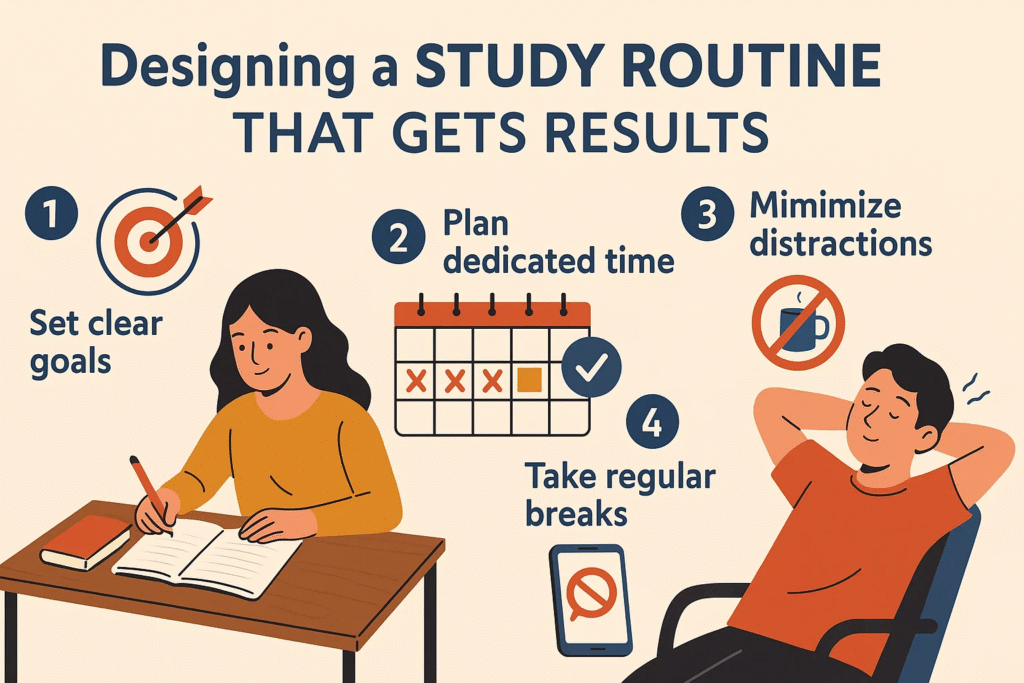Creating a study routine that truly delivers results is more than simply allocating hours to study. It requires a careful blend of planning, prioritization, and consistency. Many students struggle to maintain regular study habits, feel overwhelmed by assignments, or find themselves procrastinating frequently. A well-structured study routine not only improves academic performance but also reduces stress, increases productivity, and helps build long-term learning habits that extend beyond exams. This comprehensive guide will help you design a study routine tailored to your learning style, energy levels, and goals.
Why a Study Routine Matters
A study routine provides structure in an otherwise chaotic academic schedule. Without a clear plan, students often waste time deciding what to study next, leading to lower productivity and higher stress levels. A routine ensures that every subject receives attention, critical topics are prioritized, and revision is included regularly. Beyond academic benefits, it cultivates discipline, improves time management, and allows for a balanced life with adequate rest and recreational time. Students following a proper routine often notice improved memory retention, better focus during study sessions, and more confidence when approaching exams.

| Benefit | How It Helps | Example |
|---|---|---|
| Time Management | Allocates specific time slots for each subject | Assigning 2 hours to mathematics daily ensures no topic is left incomplete |
| Stress Reduction | Reduces last-minute exam panic | Weekly planning avoids cramming sessions before exams |
| Improved Retention | Regular, focused sessions improve memory | Daily review of notes helps retain concepts longer |
| Productivity | Prevents distractions by setting clear tasks | Using study blocks for high-focus subjects maximizes output |
| Progress Tracking | Monitoring study time and goals | Checking completed topics against the schedule reveals areas needing attention |
A balanced study routine also prevents burnout by combining study hours with breaks, exercise, and leisure activities, ensuring students maintain mental and physical well-being.
Assess Your Academic Goals
The first step in designing an effective study routine is to identify your goals. Understanding what you want to achieve allows you to allocate time efficiently and focus on subjects or topics that require more attention. Start by asking yourself which subjects you struggle with, the upcoming exams or assignments you must prepare for, and the number of hours you can realistically dedicate to studying each day without overloading yourself.
| Goal Type | Example | Suggested Daily Time |
|---|---|---|
| Short-term | Complete weekly homework or assignments | 1–2 hours |
| Medium-term | Prepare for a quiz or test | 3–5 hours per week |
| Long-term | Final exam preparation | 10–15 hours per week |
It is essential to prioritize difficult subjects or areas where your understanding is weak. Assign these subjects to the times of day when your concentration and energy are at their peak. Conversely, easier topics or subjects you are confident in can be scheduled for lower-energy periods to maintain balance.
Analyze Your Available Time
Understanding how your day is structured is critical to designing a study routine that works. Break the day into time slots that match your natural energy levels and attention span. Morning hours are typically best for high-focus subjects, afternoons can be used for moderate-intensity study, and evenings are ideal for review sessions or lighter tasks.
| Time of Day | Best Activities | Notes |
|---|---|---|
| 6:00–9:00 AM | High-focus subjects, problem-solving | Brain is fresh and fewer distractions |
| 9:00 AM–12:00 PM | Moderate study, reading, practice exercises | Include a short break midway |
| 12:00–1:00 PM | Lunch and rest | Recharge for afternoon sessions |
| 1:00–4:00 PM | Assignments, projects, practice | Avoid intensive study if energy dips |
| 4:00–6:00 PM | Quick review, light subjects | Use this for memorization or flashcards |
| 6:00–10:00 PM | Revision, practice tests, creative tasks | Include short breaks to prevent fatigue |
Allocating breaks strategically enhances focus and retention. Research suggests studying for 50–60 minutes followed by a 10–15 minute break optimizes productivity and prevents mental fatigue.
Prioritize Subjects and Topics
Not all subjects are equal, and some require more attention than others. Prioritize subjects based on difficulty, importance, and deadlines. Allocate more time to challenging subjects and less to easier ones. This ensures your energy is directed where it matters most and prevents weaker subjects from being neglected.
| Subject Priority | Suggested Time Allocation | Notes |
|---|---|---|
| High (difficult) | 40–50% of study time | Tackle these during peak energy hours for maximum focus |
| Medium (moderate) | 30–35% of study time | Alternate days or split sessions |
| Low (easy) | 15–20% of study time | Quick revisions or practice questions |
The key is to approach difficult topics first, ensuring they receive your full attention before fatigue sets in. Once high-priority subjects are addressed, the remaining time can be used for moderate or easy topics.
Design Study Blocks
Breaking your study time into blocks helps maintain focus and prevents burnout. Each block should focus on a single subject or activity, followed by a short break to refresh the mind.
| Study Block | Duration | Activity |
|---|---|---|
| Block 1 | 60 minutes | High-focus subject study |
| Break 1 | 10 minutes | Hydration, stretching |
| Block 2 | 50 minutes | Medium-priority subject |
| Break 2 | 15 minutes | Quick walk or snack |
| Block 3 | 60 minutes | Revision or practice questions |
| Break 3 | 10 minutes | Relaxation and light movement |
| Block 4 | 45 minutes | Light review, flashcards, or group discussion |
Techniques such as the Pomodoro method, which involves 25–50 minutes of study followed by a 5–10 minute break, can significantly enhance concentration and prevent mental exhaustion.
Incorporate Revision and Practice
Revision is a cornerstone of an effective study routine. Consistent review reinforces learning, ensures retention, and boosts confidence. Practice tests and mock exams should also be integrated into the schedule to simulate real exam conditions and assess understanding.
| Frequency | Activity |
|---|---|
| Daily | Quick review of notes, flashcards |
| Weekly | Summarize topics and attempt practice questions |
| Monthly | Full-length mock tests or past papers |
| Pre-Exam | Intensive revision and problem-solving |
Students should pay extra attention to topics they find difficult, revisiting them multiple times to ensure clarity and mastery. This method reduces last-minute cramming and enhances performance during exams.
Track Progress and Make Adjustments
Even the most meticulously planned routine may need adjustments. Monitoring your progress helps identify areas where time allocation may need changes, tasks may be piling up, or energy levels are inconsistent.
| Metric | How to Track |
|---|---|
| Hours Studied | Use a digital planner or calendar |
| Task Completion | Daily checklists or apps |
| Subject Understanding | Self-assessment or quizzes |
| Focus and Energy | Note peak and low-energy periods |
Flexibility is key. Adjust study blocks based on challenging subjects, deadlines, or personal energy cycles. Over time, the routine will evolve to perfectly match your learning pace and goals.
Tools to Help Maintain a Study Routine
Several apps and tools can help you stay organized and focused. Planner apps such as Google Calendar, Notion, and Todoist are excellent for scheduling study blocks. Focus apps like Forest, BeFocused, or Pomofocus help eliminate distractions. Flashcards using Quizlet or Anki aid in quick memory recall, while timers help manage study blocks effectively. Visualizing your routine through digital or paper planners ensures discipline and consistency.
FAQs
1. How long should each study session be?
Sessions of 50–60 minutes are ideal. Shorter sessions may reduce focus, while longer sessions can lead to fatigue.
2. How many hours should I study daily?
This depends on individual goals. For regular students, 4–6 hours may suffice, while intensive exam preparation may require 8–10 hours.
3. Should I study the same subject every day?
Rotating subjects based on priority and energy levels keeps the mind engaged and prevents monotony.
4. How can I minimize distractions while studying?
Choose quiet locations, turn off notifications, and use focus apps or timers to maintain attention.
5. Can a study routine help with procrastination?
Yes. A structured routine reduces indecision and encourages accountability, significantly decreasing procrastination.
6. How often should I revise topics?
Short daily reviews, weekly in-depth revisions, and monthly full-length practice sessions are most effective.
Advanced Tips for an Effective Study Routine
Balancing study and rest is essential for optimal learning. Incorporate active and passive learning, mixing reading, problem-solving, flashcards, and discussions. Prioritize sleep and schedule short breaks to improve retention. Color-coding subjects or tasks visually organizes priorities and helps track progress. Setting SMART goals (Specific, Measurable, Achievable, Relevant, Time-bound) ensures measurable progress. Finally, brief reviews before sleep and in the morning enhance memory consolidation.
Conclusion
Designing a study routine that gets results is a process of understanding your goals, analyzing available time, prioritizing subjects, and creating focused study blocks. By incorporating regular revision, practice sessions, and tracking your progress, your study routine becomes a powerful tool for academic success. Flexibility, consistency, and balanced scheduling ensure that the routine remains effective and sustainable. Over time, this approach will not only improve grades but also instill confidence, reduce stress, and foster habits that support lifelong learning.

